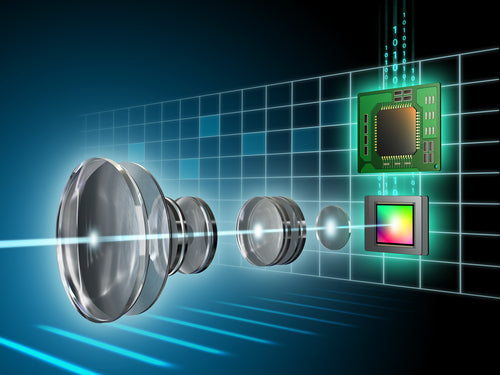It is not easy deciding which camera to use for your application taking into consideration all your requirements and budget but also the wealth of different cameras from different manufacturers and sensor specifications. Looking at the sensor level you have different pixel sizes, total pixel number, signal-to-noise ratio, (high) dynamic range etc.
However, once you have made your camera decision the journey is not over yet.
In order to get the best images you also need a lens that fits to your application and your sensor. It is not only important to consider working distance, sensor size, required field of view to determine the focal length of the lens but also to look at the actual lens performance.
If all this seems too much (understandably) and you don't have the confidence to make your own lens selection, we can help. For a discussion on your application, with no obligation to buy whatsoever, please call us.
Lens Performance and MTF
Lens performance will give insight into the pixel size which the lens can resolve at a specific working distance, f/#, wavelength (range) and sensor size as well as sensor position. Optic designers often refer to the lens performance as MTF (modulus of transfer function). MTF is usually shown as a plot with contrast level from 0-1 on the y-axis and increasing resolution or frequency on the x-axis in line pairs/mm or cycles/mm. An explanation for MTF plots and how to read it is explained in another blog post. Line pairs/mm can be converted to micron which is a more common denominator for pixel size from camera manufacturers.
What is the Megapixel Rating Anyway?
Lens manufacturers often specify their lenses with a specific MP number to indicate the resolution of the lens. This is however not very helpful when it comes to choosing the right lens as 12 MP on a 1” sensor clearly means a larger pixel size than 12 MP on a ½” sensor. Resolution is the ability of a lens to distinguish two lines or squares as separate objects.
When you have chosen your camera you will have a specific sensor and can either look up the pixel size, or it may be given in the camera specs. Let’s say your camera has the Sony IMX249 sensor with a pixel size of 5.86 micron. In the best case you want to have a lens which can resolve this pixel size so that you do not lose resolution, pay a higher price for a sensor but cannot work at the sensor limits because of your lens’ limitations. Your aim should always be to work sensor limited rather than lens limited. In an ideal case you can ask the lens supplier to provide an MTF curve at your specific working distance, sensor size, f/# and wavelength to check for the performance.
Taken the example above with the IMX249 sensor and 5.86 micron pixel size you have the choice of different lenses with different resolution limits. They may differ in price, size or other features e.g. weight.
Lens Limited versus Sensor Limited
Keeping in mind that resolution is the ability to resolve two features from each other you want to use a lens that can do exactly this with your sensor’s pixel. A lens will focus rays onto the sensor. If rays can be focused within the size of one pixel you will work sensor limited. If rays cannot be focused within one pixel because of the lens’ ability you will be lens limited and use more than one pixel for rays to focus on. This relates to the airy disk.
If you have 5.86 micron pixel you want a lens to resolve this or in other words to be able to focus rays within this pixel. If your lens can only resolve 8 micron you will lose resolution on the sensor and work lens limited.

